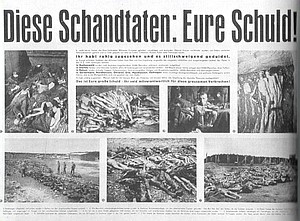| The
Discovery of Genocide (back to top)
- Dachau statistics
- HALF of all 36,000+ named deaths occurred in last 6 months before
liberation (Nov. 1944-Apr. 1945), thus equal numbers in almost 12
years vs. 1/2 year.
- 1933-1944: average of 4 deaths per day
1945: more than 100 deaths per day
- 1940-1943: 1000-3000 deaths per year�
(avg. 80-250/mo only twice more than 400 per month)
- 1944: 403 in October
997 in Nov.
1,915 in
Dec.
1945: 2,625-3,977 per month from Jan. to Apr.
- Commandant Kramer of Belsen to SS administration in Berlin, March
1, 1945 shows how utterly out of control the situation had become.
- "You informed
me me by telegram of 23rd February, 1945, that I was to receive 2,500
female detainees as a first consignment from Ravensbrück. I have
assured accommodation for this number. The reception of further consignments
is impossible, not only from the point of view of accommodation due
to lack of space, but particularly on account of the feeding question.
.... [I]t was decided that the camp could not hold more than 35,000
detainees. In the meantime this number has been exceeded by 7,000
and a further 6,200 are now on their way. As a result all barracks
are overcrowded by at least 30%. ... In addition to this question,
a spotted fever and typhus epidemic has now begun, which is spreading
every day. The daily mortality rate, which was still in the vicinity
of 60-70 at the beginning of February, has now attained a daily average
of 250-300 and will increase further in light of the prevailing conditions."

(note: Anne Frank and her sister were dying in Belsen at this time)
- Allied response: blame the Germans, rub their noses in the atrocities
they perpetrated!
- German response: The "Three Myths"
- Myth of ignorance: "We didn't know"
became: We don't want to know
- Myth of victimization: "good Germans" were victims of
"bad Nazis"
became: victims of Allies (later: tourists)
- Myth of resistance: Inasmuch as we knew, we resisted
became: we know enough; sites should be cleaned up, survivors are
unimportant
- The Allied policies thus had to get the Germans to learn what had
happened, make them feel responsible for it, and keep them from becoming
too active in resisting those lessons.
- How these myths played out over time played an important role in West
and East German political culture for decades. We will return to these
myths and their consequences in lecture 16.
|